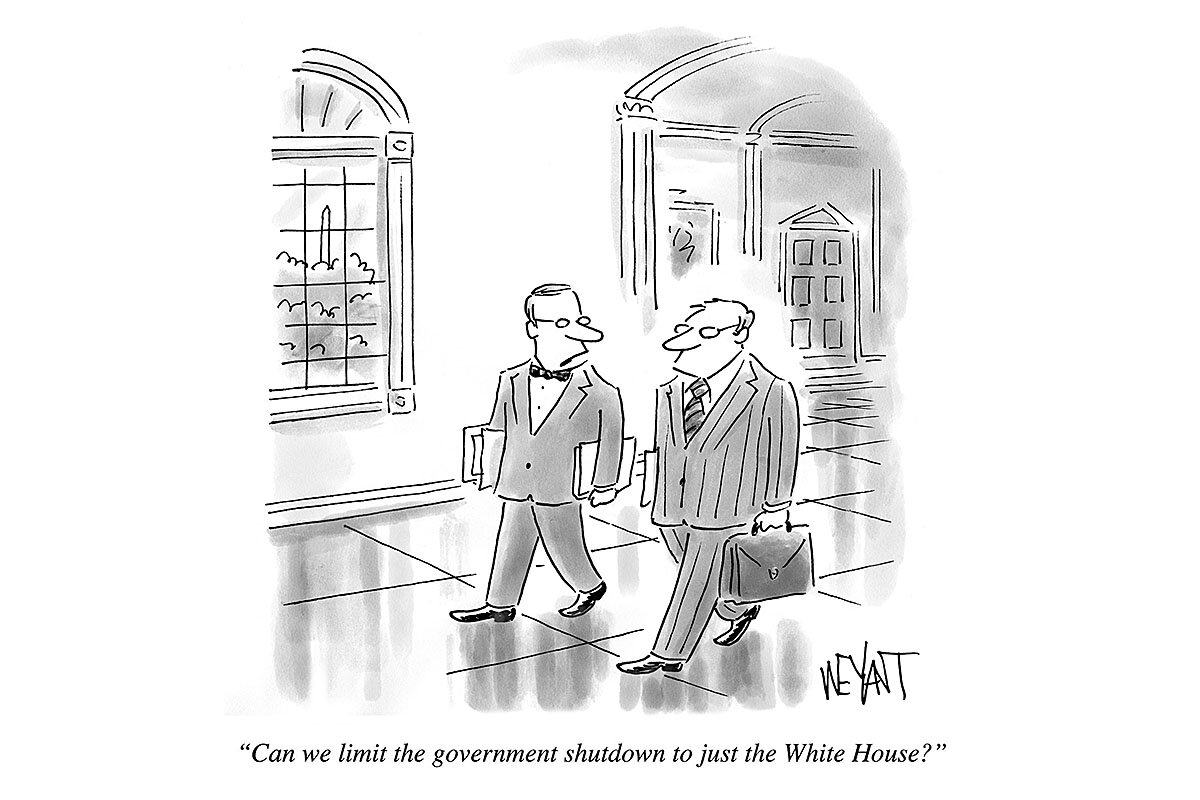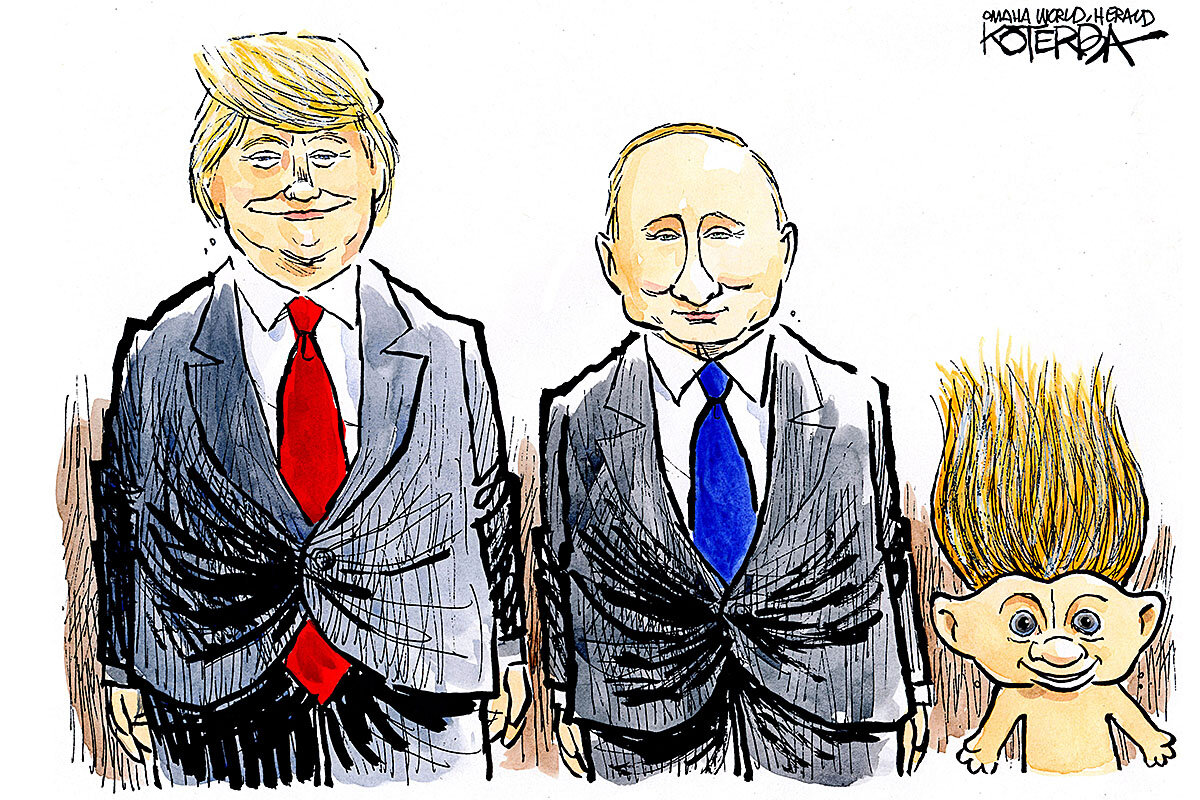Think Trump is a gift to cartoonists? They beg to differ.
Loading...
Creating good Trump cartoons is so hard it’s not even funny.
The ironic thing is, drawing him is easy. The pursed lips, the puff of golden hair, the iconic hand gestures – they beckon the pencil. A cartoonist might chortle to himself, This is going to be huge! HUGE! We’re going to draw tremendous cartoons. Because that’s what our great country needs. We’re going to make America laugh again!
But President Trump has stolen their thunder.
Why We Wrote This
In an era of tribalism and rage, helping people see things from a different perspective is harder than it looks. Through humor and satire, cartoonists hope they can help the country get to a better place.
“How do you caricature something that’s a caricature of itself?” asks Nate Beeler, editorial cartoonist for The Columbus Dispatch in Ohio. “The stuff that he does, a lot of it … is even more hyperbolic than I would draw.”
Mr. Trump, with his unorthodox style and disdain for political correctness, might seem like the perfect gift for saving a nearly extinct species: the staff editorial cartoonist. (There are fewer than 30 left in the US, according to several cartoonists interviewed for this piece.) But in fact, his ascent has proved challenging in many ways.
It’s hard to be edgy and push the envelope when Trump has already ripped it open. To keep your eye on the big ideas when tweets are falling around you like confetti. To make people think when all they want to do is yell from within their tribal bunker.
It’s enough to leave even the best cartoonists at wits’ end – and they’re not even halfway through Trump’s term.
Cartoonists’ struggles and triumphs are part of a broader American reckoning with who we are as a nation and who we want to be, a difficult exercise in negotiating deeply-held convictions in today’s “age of rage.” Cartoonists, who see themselves as canaries in the coal mine, are grappling with these issues in a very public arena – and feeling the heat. Readers, especially who have experienced a political awakening, are embracing their role as gatekeepers as vigorously as cartoonists themselves.
But cartoonists hope that caricature, humor, and satire, even if biting, can help the country get to a better place. Cartoons can act as a soothing salve, a pressure relief valve, or a way to jolt us out of our tribal mind-set and see something from a new perspective.
“I think in times of great polarization, people turn to cartoons to help them cope or perhaps even allow them to say what we can’t as part of a public social contract,” says Christopher Weyant, a cartoonist for The New Yorker and The Boston Globe whose lampooning of Trump’s policies has brought an unfamiliar kind of feedback: heartfelt thanks. “Once we laugh at something, we no longer fear it.”
A silver lining to hate mail
Ever since Trump’s election, readers have been telling Mr. Weyant, “I couldn’t have gotten through the week without you.”
One such cartoon depicted a squat Trump standing at the base of the Statue of Liberty, a hammer in hand, with a new sign covering up the words of Emma Lazarus’s poem, “Give me your tired …”
The sign reads, “Whites Only.”
“I’m way out there on the bow of the ship in terms of the First Amendment,” says Weyant, whose hard-hitting cartoons have been held up in street protests but have also drawn complaints from readers that his work is not balanced. “Of course it’s not balanced. If I balanced it, it wouldn’t be funny.”
Many cartoonists proudly recite by heart some of their hate mail, most of which is not printable here. The tone has sharpened since 2016, however.
“People have gotten a lot more unhinged in the Trump era – and that’s not necessarily Trump’s fault. It’s also the reaction to Trump,” says Mr. Beeler, who leans libertarian but has criticized the president.
Still, some find harsh feedback reassuring in a way. “I take comfort in the fact that they are passionate,” says Jeffrey Koterba, editorial cartoonist for the Omaha World-Herald in Nebraska, who calls back people who have left him scathing voicemails – and even became friends with one of them. “At least they’re engaged.”
Cartoonists themselves aren’t immune to anger and divisiveness, of course, and it can be tempting to skewer the president personally – depicting him as a petulant child, for example – without making a deeper point about his policies and holding him accountable.
“If I were showing Trump as that tantrum baby, I feel like that immediately undermines whatever the idea was,” says Mr. Koterba. “I want to get into the meat.”
The cartoonist who ousted a politician
The First Amendment right to poke fun at elected politicians is critical to American democracy, says Jenny Robb, curator of the Billy Ireland Cartoon Library and Museum at Ohio State University in Columbus. It also has a long history.
“I think there are some people who argue that the president, whoever it may be, deserves a certain amount of respect, simply because of the office the person holds,” says Ms. Robb. “As someone who loves political cartooning and satire, I don’t particularly agree.”
Within a generation of the American Revolution, a cartoonist depicted President Andrew Jackson in a king’s robe. Abraham Lincoln was skewered for his support of emancipation. And during the Watergate era, Herbert Lawrence Block, a cartoonist who went by “Herblock” and often depicted the president with a 5 o’clock shadow, got so under Richard Nixon’s skin that the president forbade the Post from being delivered to the White House doorstep, and reportedly started shaving twice a day.
But the last time a cartoonist actually drove a politician out of office was in 1871, when Thomas Nast drew a series of cartoons that brought down Boss Tweed and the Democratic political machine he had created at Tammany Hall.
Some cartoonists feel Trump’s unorthodox approach to governing has given them carte blanche to attack his presidency with unprecedented vigor.
But conservative cartoonists today aren’t nearly as critical as liberal cartoonists were during the Obama and Clinton administrations, says Sara Duke, curator of Popular and Applied Graphic Art at the Library of Congress in Washington.
“When the heat is on Trump, they’ll draw an anti-Obama cartoon or a donkey,” she says of conservative cartoonists. “I think the right has a lot to criticize.”
There are exceptions to that though, and she points to Beeler as well as Scott Stantis, a former Republican operative and longtime cartoonist at The Chicago Tribune. (Pro-Trump cartoonist Mike Lester did not respond to an interview request.)
Where do you draw the line?
Mr. Stantis, who sold his first cartoon for $10 in 1978, says he is dealing with issues that he never thought in his wildest imagination he’d have to address – such as Americans feeling lukewarm about the First Amendment, or what he describes as Trump’s lack of respect for the office of the presidency.
“Do you draw Trump in a brown shirt with a red armband?” asks Stantis, referring to the Nazi party uniform. “I don’t think we’re there.”
So where does he draw the line? Some have gotten in hot water for their work, like veteran cartoonist Rob Rogers, who, after 25 years on staff, was fired last June by the Pittsburgh Post-Gazette after a series of searing cartoons about Trump. Before he was let go, 19 of his cartoons and sketched ideas were rejected by his editors, including a drawing of a road sign that read “Caution” and depicted a Trump-like silhouette grabbing a child as her parents fled, commentary on the separation of migrant families at the southern border.
There is a risk and a cost cartoonists bear for their work, as Mr. Rogers’s termination illustrates. Still, Stantis, whose family traces its roots back to the Ardèche area of France, home to famous prehistoric cave paintings, says the cartoonist species has come a long way and will likely survive both the demise of newspapers and the rise of Trump.
“We’re never going to go away,” says Stantis. “There’s always one of us in every tribe.”







